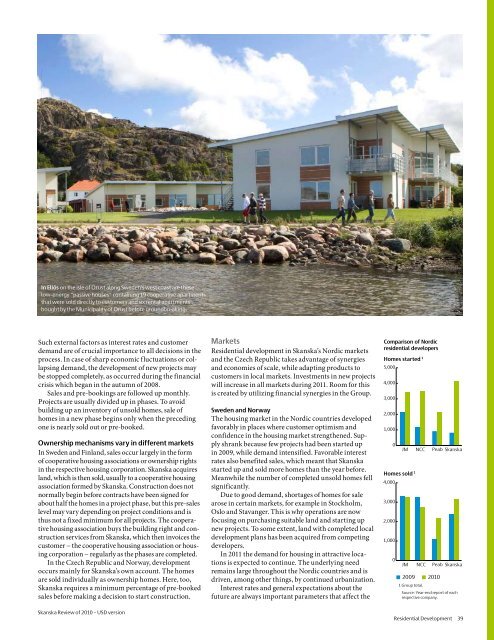Review of 2010 â USD version - Skanska
Review of 2010 â USD version - Skanska
Review of 2010 â USD version - Skanska
You also want an ePaper? Increase the reach of your titles
YUMPU automatically turns print PDFs into web optimized ePapers that Google loves.
In Ellös on the isle <strong>of</strong> Orust along Sweden’s west coast are these<br />
low-energy “passive houses” containing 19 cooperative apartments<br />
that were sold directly to customers and six rental apartments<br />
bought by the Municipality <strong>of</strong> Orust before groundbreaking.<br />
Such external factors as interest rates and customer<br />
demand are <strong>of</strong> crucial importance to all decisions in the<br />
process. In case <strong>of</strong> sharp economic fluctuations or collapsing<br />
demand, the development <strong>of</strong> new projects may<br />
be stopped completely, as occurred during the financial<br />
crisis which began in the autumn <strong>of</strong> 2008.<br />
Sales and pre-bookings are followed up monthly.<br />
Projects are usually divided up in phases. To avoid<br />
building up an inventory <strong>of</strong> unsold homes, sale <strong>of</strong><br />
homes in a new phase begins only when the preceding<br />
one is nearly sold out or pre-booked.<br />
Ownership mechanisms vary in different markets<br />
In Sweden and Finland, sales occur largely in the form<br />
<strong>of</strong> cooperative housing associations or ownership rights<br />
in the respective housing corporation. <strong>Skanska</strong> acquires<br />
land, which is then sold, usually to a cooperative housing<br />
association formed by <strong>Skanska</strong>. Construction does not<br />
normally begin before contracts have been signed for<br />
about half the homes in a project phase, but this pre-sales<br />
level may vary depending on project conditions and is<br />
thus not a fixed minimum for all projects. The cooperative<br />
housing association buys the building right and construction<br />
services from <strong>Skanska</strong>, which then invoices the<br />
customer − the cooperative housing association or housing<br />
corporation − regularly as the phases are completed.<br />
In the Czech Republic and Norway, development<br />
occurs mainly for <strong>Skanska</strong>’s own account. The homes<br />
are sold individually as ownership homes. Here, too,<br />
<strong>Skanska</strong> requires a minimum percentage <strong>of</strong> pre-booked<br />
sales before making a decision to start construction.<br />
<strong>Skanska</strong> <strong>Review</strong> <strong>of</strong> <strong>2010</strong> – <strong>USD</strong> <strong>version</strong><br />
Markets Jämförelse nordiska bostadsutvecklare<br />
development in <strong>Skanska</strong>’s Nordic markets<br />
Residential<br />
and Startade the Czech bostäder Republic 1) takes advantage <strong>of</strong> synergies<br />
and 5 economies 000 <strong>of</strong> scale, while adapting products to<br />
customers in local markets. Investments in new projects<br />
4 000<br />
will increase in all markets during 2011. Room for this<br />
is created by utilizing financial synergies in the Group.<br />
3 000<br />
Sweden and Norway<br />
2 000<br />
The housing market in the Nordic countries developed<br />
favorably 1 000 in places where customer optimism and<br />
confidence in the housing market strengthened. Supply<br />
shrank 0 because few projects had been started up<br />
JM NCC Peab <strong>Skanska</strong><br />
in 2009, while demand intensified. Favorable interest<br />
rates Sålda also bostäder benefited sales, which meant that <strong>Skanska</strong><br />
1)<br />
started up and sold more homes than the year before.<br />
4 000<br />
Meanwhile the number <strong>of</strong> completed unsold homes fell<br />
significantly.<br />
3 000<br />
Due to good demand, shortages <strong>of</strong> homes for sale<br />
arose in certain markets, for example in Stockholm,<br />
Oslo 2 and 000 Stavanger. This is why operations are now<br />
focusing on purchasing suitable land and starting up<br />
new 1 projects. 000 To some extent, land with completed local<br />
development plans has been acquired from competing<br />
developers.<br />
0<br />
In 2011 JMthe demand NCC Peabfor <strong>Skanska</strong> housing in attractive locations<br />
is expected to continue. The underlying need<br />
remains large throughout the Nordic countries and is<br />
1) Totalt i respektive koncern.<br />
driven, among other things, by continued urbanization.<br />
Källa: Respektive bolags<br />
Interest Bokslutskommuniké.<br />
rates and general expectations about the<br />
future are always important parameters that affect the<br />
Comparison <strong>of</strong> Nordic<br />
residential developers<br />
Homes started 1<br />
5,000<br />
4,000<br />
3,000<br />
2,000<br />
1,000<br />
• 2009 • <strong>2010</strong> • 2009 • <strong>2010</strong><br />
0<br />
Homes sold 1<br />
4,000<br />
3,000<br />
2,000<br />
1,000<br />
0<br />
JM NCC Peab <strong>Skanska</strong><br />
JM NCC Peab <strong>Skanska</strong><br />
1 Group total.<br />
Source: Year-end report <strong>of</strong> each<br />
respective company.<br />
Residential Development 39

















